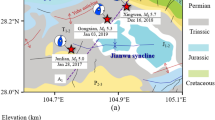Abstract
The observation of the fault-zone trapped waves was conducted using a seismic line with dense receivers across surface rupture zone of the M=8.1 Kunlun Mountain earthquake. The fault zone trapped waves were separated from seismograms by numerical filtering and spectral analyzing. The results show that: a) Both explosion and earthquake sources can excite fault-zone trapped waves, as long as they locate in or near the fault zone; b) Most energy of the fault-zone trapped waves concentrates in the fault zone and the amplitudes strongly decay with the distance from observation point to the fault zone; c) Dominant frequencies of the fault-zone trapped waves are related to the width of the fault zone and the velocity of the media in it. The wider the fault zone or the lower the velocity is, the lower the dominant frequencies are; d) For fault zone trapped waves, there exist dispersions; e) Based on the fault zone trapped waves observed in Kunlun Mountain Pass region, the width of the rupture plane is deduced to be about 300 m and is greater than that on the surface.
Similar content being viewed by others
References
CHEN Wen-bin, XU Xi-wei, ZHANG Zhi-jian et al. 2001. Preparatory field investigation on the surface deformation zone of the Qinghai-Xinjiang M S=8.1 earthquake on Nov. 14, 2001 [J]. Northwestern Seismological Journal, 23(4): 313–317 (in Chinese).
Li Y G, Aki K, Adams D et al. 1994a. Seismic guided waves trapped in the fault zone of the Landers, California, earthquake of 1992 [J]. J Geophys Res, 99: 11 705–11 722.
Li Y G, Aki K, Vidale J E et al. 1998. A delineation of the Nojima fault ruptured in the M=7.2 Kobe, Japan, earthquake of 1995 using fault zone trapped waves [J]. J Geophys Res, 103: 7 247–7 263.
Li Y G, Aki K, Vidale J E et al. 1999. Shallow structure of the Landers fault zone using explosion-excited trapped waves [J]. J Geophys Res, 104: 20 257–20 275.
Li Y G and Vidale J E. 2001. Healing of the shallow fault zone from 1994–1998 after the 1992 M=7.5 Landers, California earthquake [J]. Geophys Res Lett, 28: 2 999–3 002.
Li Y G, Vidale J E, Aki K et al. 1994b. Fine structure of the Landers fault zone, segmentation and the rupture process [J]. Science, 256: 367–370.
Li Y G, Vidale J E, Aki K. 2000. Depth-dependent structure of the Landers fault zone using fault zone trapped waves generated by aftershocks [J]. J Geophys Res, 105: 6 237–6 254.
Li Y G, Vidale J E, Day S M et al. 2002. Study of the 1999 M=7.1 Hector Mine, California earthquake fault plane by trapped waves [J]. Bull Seism Soc Amer, 92: 1 318–1 332.
Li Y G, Vidale J E, Oglesby D D et al. 2003. Multiple-fault rupture of the M=7.1 Hector Mine, California earthquake from fault-zone trapped waves [J]. J Geophys Res, 108: 2 165–2 190.
Author information
Authors and Affiliations
Additional information
Foundation item: Joint Earthquake Science Foundation of China (201001).
Contribution No. RCEG200305, Research Center of Exploration Geophysics, China Earthquake Administration.
About this article
Cite this article
Li, Sl., Zhang, Xk. & Fan, Jc. Study on rupture zone of the M=8.1 Kunlun Mountain earthquake using fault-zone trapped waves. Acta Seimol. Sin. 18, 43–52 (2005). https://doi.org/10.1007/s11589-005-0005-0
Received:
Revised:
Accepted:
Issue Date:
DOI: https://doi.org/10.1007/s11589-005-0005-0




